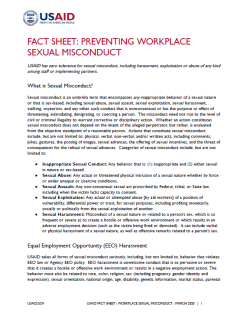USAID has zero tolerance for sexual misconduct, including harassment, exploitation or abuse of any kind among staff or implementing partners.
What is Sexual Misconduct?
Sexual misconduct is an umbrella term that encompasses a ny inappropriate behavior of a sexual nature or that is sex-based, including sexual abuse, sexual assault, sexual exploitation, sexual harassment, stalking, voyeurism, and any other such conduct that is nonconsensual or has the purpose or effect of threatening, intimidating, denigrating, or coercing a person. The misconduct need not rise to the level of civil or criminal illegality to warrant corrective or disciplinary action. Whether an action constitutes sexual misconduct does not depend on the intent of the alleged perpetrator, but rather, is evaluated from the objective standpoint of a reasonable person. Actions that constitute sexual misconduct include, but are not limited to: physical, verbal, non-verbal, and/or written acts, including comments, jokes, gestures, the posting of images, sexual advances, the offering of sexual incentives, and the threat of consequences for the refusal of sexual advances. Categories of sexual misconduct include, but are not limited to:
- Inappropriate Sexual Conduct : Any behavior that is: (1) inappropriate and (2) either sexual in nature or sex-based.
- Sexual Abuse : Any actual or threatened physical intrusion of a sexual nature whether by force or under unequal or coercive conditions.
- Sexual Assault: Any non-consensual sexual act proscribed by Federal, tribal, or State law, including when the victim lacks capacity to consent.
- Sexual Exploitation: Any actual or attempted abuse [by aid workers] of a position of vulnerability, differential power or trust, for sexual purposes, including profiting monetarily, socially or politically from the sexual exploitation of another.
- Sexual Harassment: Misconduct of a sexual nature or related to a person’s sex, which is so frequent or severe as to create a hostile or offensive work environment or which results in an adverse employment decision (such as the victim being fired or demoted). It can include verbal or physical harassment of a sexual nature, as well as offensive remarks related to a person’s sex.

